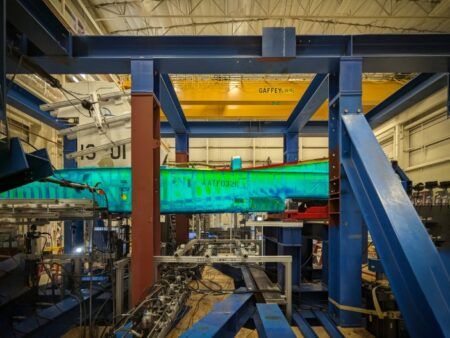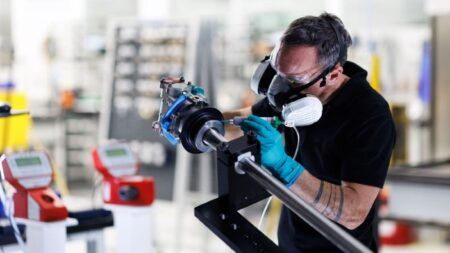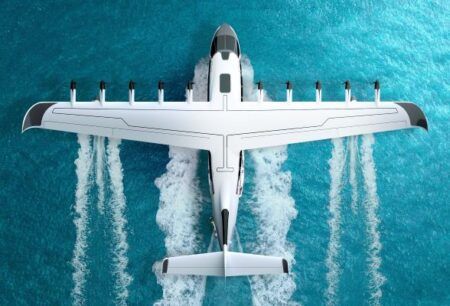NASA’s X-59 Quesst quiet supersonic research aircraft has passed key engine and electromagnetic testing programs before its planned first flight later this year.
Data from the test flights will help establish an acceptable noise standard for commercial supersonic flights over land, lifting a 50-year ban.
This will be a vital regulatory step for companies such as USA-based Boom, which is developing a commercial supersonic passenger aircraft.
Engine tests
The modified F414-GE-100 engine performed to expectations during the three increasingly complicated tests which were ran between October and January at main contractor Lockheed Martin’s Skunk Works facility in Palmdale, California.
Raymond Castner, X-59 propulsion lead at NASA’s Glenn Research Center said, “We had no showstoppers. We were getting smooth and steady airflow as predicted from the wind tunnel testing. We didn’t have any structural or excessive vibration issues. And parts of the engine and aircraft that needed cooling were getting it.”
The tests began with assessing how the aircraft’s hydraulics, electrical and environmental control systems performed when the engine was powered up but idling. Engineers then performed throttle checks, bringing the aircraft up to full power and firing its afterburner.
A third test, throttle snaps involved moving the throttle swiftly back and forth to validate that the engine responds instantly. X-59’s engine produces as much as 22,000 lbs of thrust to achieve the desired cruising speed of Mach 1.4 (925mph) at an altitude of 55,000ft.
The F414-GE-100 engine, which is also used in the US Navy’s F-18 Super Hornet is mounted on top of the aircraft to reduce the level of noise reaching the ground. The X-59’s 38ft-long nose will also lower the noise of sonic booms to a “thump,” similar to the sound of a car door slamming nearby.
Electromagnetic Testing
Following the engine tests, electromagnetic testing was carried out to examine the X-59’s internal electronic systems. These tests confirmed that the X-59’s systems such as radios, navigation equipment and sensors can work together safely, without interference from each other or external sources disrupting critical systems.
Yohan Lin, NASA’s X-59 avionics lead said, “Reaching this phase shows that aircraft integration is advancing. It’s exciting to see the progress, knowing we’ve cleared a major hurdle that moves us closer to X-59’s first flight.”
The electromagnetic interference (EMI) tests were also conducted at the Skunk Works’ facility. During the tests, engineers activated each system on the aircraft one at a time while they monitored the other systems for possible interference.
“This testing helped us determine whether the systems within the X-59 are interfering with each other. It’s called a source-victim test – essentially, we activate one system and monitor the other for issues like noise, glitches, faults, or errors,” said Lin.
The X-59 is the centerpiece of NASA’s Quesst mission and is progressing steadily through ground tests to ensure safety and performance.
Other electromagnetic interference testing involved the team looking at the operation of the X-59’s landing gear, ensuring this critical component can extend and retract without affecting other systems. Engineers also tested that the fuel switch shutoff was functioning properly without interference.
To ensure the X-59’s systems will function properly when it eventually flies near other NASA research aircraft, researchers staged the X-59 on the ground in front of NASA’s F-15D, placing them 47ft (14m) apart, then 500ft (150m) apart. The proximity of the two aircraft replicated conditions needed for the F-15D to use a special probe to gather measurements about the shock waves the X-59 will produce.
“We want to confirm there’s compatibility between the two aircraft, even at close proximity,” Lin said.
For the tests the team powered up the X-59’s engine while turning on the F-15D’s radar, C-band radar transponder, and radios. Data from the X-59 were transmitted to NASA’s mobile operations facility, where control room staff and engineers monitored for anomalies.
“You want to make discoveries of any potential electromagnetic interference or electromagnetic compatibility issues on the ground first,” Lin said. “This reduces risk and ensures we’re not learning about problems in the air.”
The next stage of testing for X-59 will be aluminum bird tests, during which data will be fed to the aircraft on the ground under both normal and failure conditions and then taxi tests before flight.





